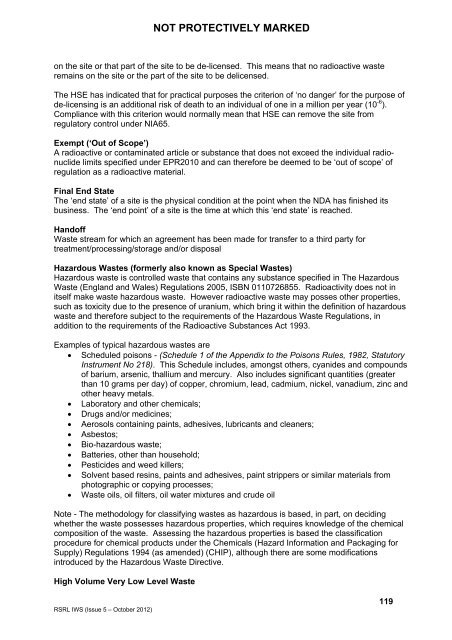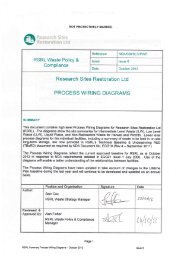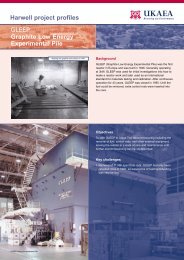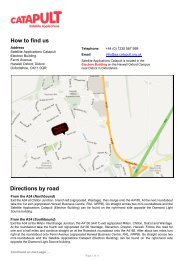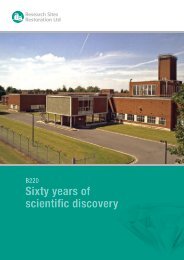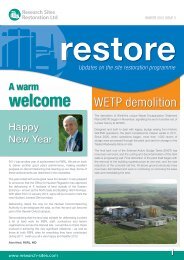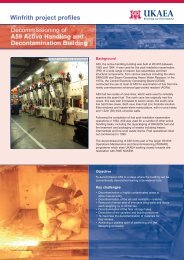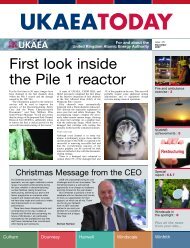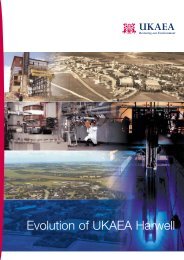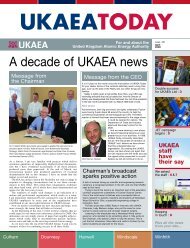RSRL Integrated Waste Strategy - Issue 5- Oct 2012.pdf
RSRL Integrated Waste Strategy - Issue 5- Oct 2012.pdf
RSRL Integrated Waste Strategy - Issue 5- Oct 2012.pdf
Create successful ePaper yourself
Turn your PDF publications into a flip-book with our unique Google optimized e-Paper software.
NOT PROTECTIVELY MARKEDon the site or that part of the site to be de-licensed. This means that no radioactive wasteremains on the site or the part of the site to be delicensed.The HSE has indicated that for practical purposes the criterion of ‘no danger’ for the purpose ofde-licensing is an additional risk of death to an individual of one in a million per year (10 -6 ).Compliance with this criterion would normally mean that HSE can remove the site fromregulatory control under NIA65.Exempt (‘Out of Scope’)A radioactive or contaminated article or substance that does not exceed the individual radionuclidelimits specified under EPR2010 and can therefore be deemed to be ‘out of scope’ ofregulation as a radioactive material.Final End StateThe ‘end state’ of a site is the physical condition at the point when the NDA has finished itsbusiness. The ‘end point’ of a site is the time at which this ‘end state’ is reached.Handoff<strong>Waste</strong> stream for which an agreement has been made for transfer to a third party fortreatment/processing/storage and/or disposalHazardous <strong>Waste</strong>s (formerly also known as Special <strong>Waste</strong>s)Hazardous waste is controlled waste that contains any substance specified in The Hazardous<strong>Waste</strong> (England and Wales) Regulations 2005, ISBN 0110726855. Radioactivity does not initself make waste hazardous waste. However radioactive waste may posses other properties,such as toxicity due to the presence of uranium, which bring it within the definition of hazardouswaste and therefore subject to the requirements of the Hazardous <strong>Waste</strong> Regulations, inaddition to the requirements of the Radioactive Substances Act 1993.Examples of typical hazardous wastes are• Scheduled poisons - (Schedule 1 of the Appendix to the Poisons Rules, 1982, StatutoryInstrument No 218). This Schedule includes, amongst others, cyanides and compoundsof barium, arsenic, thallium and mercury. Also includes significant quantities (greaterthan 10 grams per day) of copper, chromium, lead, cadmium, nickel, vanadium, zinc andother heavy metals.• Laboratory and other chemicals;• Drugs and/or medicines;• Aerosols containing paints, adhesives, lubricants and cleaners;• Asbestos;• Bio-hazardous waste;• Batteries, other than household;• Pesticides and weed killers;• Solvent based resins, paints and adhesives, paint strippers or similar materials fromphotographic or copying processes;• <strong>Waste</strong> oils, oil filters, oil water mixtures and crude oilNote - The methodology for classifying wastes as hazardous is based, in part, on decidingwhether the waste possesses hazardous properties, which requires knowledge of the chemicalcomposition of the waste. Assessing the hazardous properties is based the classificationprocedure for chemical products under the Chemicals (Hazard Information and Packaging forSupply) Regulations 1994 (as amended) (CHIP), although there are some modificationsintroduced by the Hazardous <strong>Waste</strong> Directive.High Volume Very Low Level <strong>Waste</strong><strong>RSRL</strong> IWS (<strong>Issue</strong> 5 – <strong>Oct</strong>ober 2012)119


